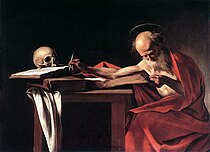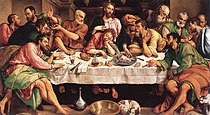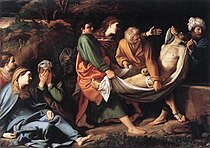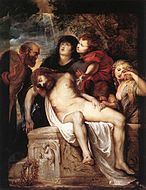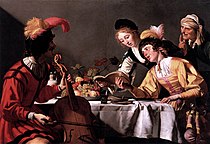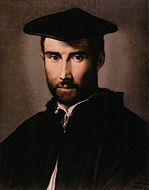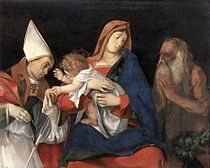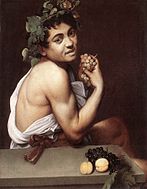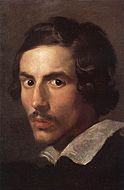Galleria Borghese: Difference between revisions
Rescuing 1 sources and tagging 0 as dead. #IABot (v1.5.6) |
|||
| Line 47: | Line 47: | ||
===Gian Lorenzo Bernini at the Borghese=== |
===Gian Lorenzo Bernini at the Borghese=== |
||
Many of the sculptures are displayed in the spaces for which they were intended, including many works by [[Gian Lorenzo Bernini]], which comprise a significant percentage of his output of secular sculpture, starting with early works such as the ''[[The Goat Amalthea with the Infant Jupiter and a Faun|Goat Amalthea with Infant Jupiter and Faun]]'' (1615) and ''[[Aeneas, Anchises, and Ascanius|Aeneas, Anchises & Ascanius]]'' (1618–19) <ref>[http://www.wga.hu/frames-e.html?/html/b/bernini/gianlore/sculptur/1610/aeneas.html Web Gallery of Art, image collection, virtual museum, searchable database of European fine arts (1100–1850)<!-- Bot generated title -->]</ref><ref>[http://www.wga.hu/frames-e.html?/html/b/bernini/gianlore/sculptur/1610/2amalthea.html Web Gallery of Art, image collection, virtual museum, searchable database of European fine arts (1100–1850)<!-- Bot generated title -->]</ref> to his dynamic ''[[Rape of Proserpine (Bernini)|Rape of Proserpine]]'' (1621–22), ''[[Apollo and Daphne (Bernini)|Apollo and Daphne]]'' (1622–25) <ref>[http://gallery.euroweb.hu/html/b/bernini/gianlore/sculptur/1620/apollo_d.html Apollo and Daphne by BERNINI, Gian Lorenzo<!-- Bot generated title -->]</ref> and ''[[David (Bernini)|David]]'' (1623) <ref>[http://www.wga.hu/frames-e.html?/html/b/bernini/gianlore/sculptur/1620/david.html Web Gallery of Art, image collection, virtual museum, searchable database of European fine arts (1100–1850)<!-- Bot generated title -->]</ref> which are considered seminal works of [[baroque]] sculpture. In addition, several portrait busts are included in the gallery, including one of [[Bust of Pope Paul V|Pope Paul V]], and two portraits of one of his early patrons, ''[[Two Busts of Cardinal Scipione Borghese|Cardinal Scipione Borghese]]'' (1632).<ref>[http://www.wga.hu/html/b/bernini/gianlore/sculptur/1630/scipione.html Bust of Scipione Borghese by BERNINI, Gian Lorenzo<!-- Bot generated title -->]</ref> The second Scipione Borghese portrait was produced after a large crack was discovered in the marble of the first version during its creation. |
Many of the sculptures are displayed in the spaces for which they were intended, including many works by [[Gian Lorenzo Bernini]], which comprise a significant percentage of his output of secular sculpture, starting with early works such as the ''[[The Goat Amalthea with the Infant Jupiter and a Faun|Goat Amalthea with Infant Jupiter and Faun]]'' (1615) and ''[[Aeneas, Anchises, and Ascanius|Aeneas, Anchises & Ascanius]]'' (1618–19) <ref>[http://www.wga.hu/frames-e.html?/html/b/bernini/gianlore/sculptur/1610/aeneas.html Web Gallery of Art, image collection, virtual museum, searchable database of European fine arts (1100–1850)<!-- Bot generated title -->]</ref><ref>[http://www.wga.hu/frames-e.html?/html/b/bernini/gianlore/sculptur/1610/2amalthea.html Web Gallery of Art, image collection, virtual museum, searchable database of European fine arts (1100–1850)<!-- Bot generated title -->]</ref> to his dynamic ''[[Rape of Proserpine (Bernini)|Rape of Proserpine]]'' (1621–22), ''[[Apollo and Daphne (Bernini)|Apollo and Daphne]]'' (1622–25) <ref>[http://gallery.euroweb.hu/html/b/bernini/gianlore/sculptur/1620/apollo_d.html Apollo and Daphne by BERNINI, Gian Lorenzo<!-- Bot generated title -->] {{webarchive|url=https://web.archive.org/web/20051115123053/http://gallery.euroweb.hu/html/b/bernini/gianlore/sculptur/1620/apollo_d.html |date=2005-11-15 }}</ref> and ''[[David (Bernini)|David]]'' (1623) <ref>[http://www.wga.hu/frames-e.html?/html/b/bernini/gianlore/sculptur/1620/david.html Web Gallery of Art, image collection, virtual museum, searchable database of European fine arts (1100–1850)<!-- Bot generated title -->]</ref> which are considered seminal works of [[baroque]] sculpture. In addition, several portrait busts are included in the gallery, including one of [[Bust of Pope Paul V|Pope Paul V]], and two portraits of one of his early patrons, ''[[Two Busts of Cardinal Scipione Borghese|Cardinal Scipione Borghese]]'' (1632).<ref>[http://www.wga.hu/html/b/bernini/gianlore/sculptur/1630/scipione.html Bust of Scipione Borghese by BERNINI, Gian Lorenzo<!-- Bot generated title -->]</ref> The second Scipione Borghese portrait was produced after a large crack was discovered in the marble of the first version during its creation. |
||
==Nearby museums== |
==Nearby museums== |
||
Revision as of 10:46, 10 October 2017
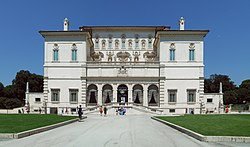 | |
| Established | 1903 |
|---|---|
| Location | Villa Borghese, Rome, Italy |
| Type | Art museum |
| Website | www |
The Galleria Borghese (English: Borghese Gallery) is an art gallery in Rome, Italy, housed in the former Villa Borghese Pinciana. At the outset, the gallery building was integrated with its gardens, but nowadays the Villa Borghese gardens are considered a separate tourist attraction. The Galleria Borghese houses a substantial part of the Borghese collection of paintings, sculpture and antiquities, begun by Cardinal Scipione Borghese, the nephew of Pope Paul V (reign 1605–1621). The Villa was built by the architect Flaminio Ponzio, developing sketches by Scipione Borghese himself, who used it as a villa suburbana, a country villa at the edge of Rome.
Scipione Borghese was an early patron of Bernini and an avid collector of works by Caravaggio, who is well represented in the collection by his Boy with a Basket of Fruit, St Jerome Writing, Sick Bacchus and others. Other paintings of note include Titian's Sacred and Profane Love, Raphael's Entombment of Christ and works by Peter Paul Rubens and Federico Barocci.
Present
The Casino Borghese lies on the outskirts of seventeenth-century Rome. By 1644, John Evelyn described it as "an Elysium of delight" with "Fountains of sundry inventions, Groves and small Rivulets of Water". Evelyn also described the Vivarium that housed ostriches, peacocks, swans and cranes "and divers strange Beasts". Prince Marcantonio IV Borghese (500-600), who began the recasting of the park's formal garden architecture into an English landscape garden, also set out about 1775, under the guidance of the architect Antonio Asprucci, to replace the now-outdated tapestry and leather hangings and renovate the Casina, restaging the Borghese sculptures and antiquities in a thematic new ordering that celebrated the Borghese position in Rome. The rehabilitation of the much-visited villa as a genuinely public museum in the late eighteenth century was the subject of an exhibition at the Getty Research Institute, Los Angeles, in 2000,[1] spurred by the Getty's acquisition of fifty-four drawings related to the project.
In 1808, Prince Camillo Borghese, Napoleon's brother-in-law,[2] was forced to sell the Borghese Roman sculptures and antiquities to the Emperor. The result is that the Borghese Gladiator, renowned since the 1620s as the most admired single sculpture in Villa Borghese, must now be appreciated in the Musée du Louvre. The "Borghese Hermaphroditus" is also now in the Louvre.
The Borghese villa was modified and extended down the years, eventually being sold to the Italian government in 1902, along with the entire Borghese estate and surrounding gardens and parkland.
Collection

The Galleria Borghese includes twenty rooms across two floors.
The main floor is mostly devoted to classical antiquities of the 1st–3rd centuries AD (including a famous 320–30 AD mosaic of gladiators found on the Borghese estate at Torrenova, on the Via Casilina outside Rome, in 1834), and classical and neo-classical sculpture such as the Venus Victrix. Its decorative scheme includes a trompe l'oeil ceiling fresco in the first room, or Salone, by the Sicilian artist Mariano Rossi makes such good use of foreshortening that it appears almost three-dimensional.
Gian Lorenzo Bernini at the Borghese
Many of the sculptures are displayed in the spaces for which they were intended, including many works by Gian Lorenzo Bernini, which comprise a significant percentage of his output of secular sculpture, starting with early works such as the Goat Amalthea with Infant Jupiter and Faun (1615) and Aeneas, Anchises & Ascanius (1618–19) [3][4] to his dynamic Rape of Proserpine (1621–22), Apollo and Daphne (1622–25) [5] and David (1623) [6] which are considered seminal works of baroque sculpture. In addition, several portrait busts are included in the gallery, including one of Pope Paul V, and two portraits of one of his early patrons, Cardinal Scipione Borghese (1632).[7] The second Scipione Borghese portrait was produced after a large crack was discovered in the marble of the first version during its creation.
Nearby museums
Also in Villa Borghese gardens or nearby are the Galleria Nazionale d'Arte Moderna, which specialises in 19th- and 20th-century Italian art, and Museo Nazionale Etrusco, a collection of pre-Roman objects, mostly Etruscan, excavated around Rome.
Collection highlights
Sculptures
Paintings
-
Melissa by Dosso Dossi. c. 1507
-
Saint Jerome Writing by Caravaggio. c. 1606
-
The Deposition by Raphael. c. 1507
-
St John the Baptist by Caravaggio. c. 1610
-
The Last Supper by Jacopo Bassano. c. 1546
-
Madonna, Child and Serpent by Caravaggio. c. 1605-1606
-
Danaë by Correggio. c. 1530
-
Boy with a Basket of Fruit by Caravaggio. c. 1593
-
Diana and Her Nymphs by Domenichino. c. 1616-1617
-
The Scourging of Christ by Titian. c. 1560
-
Deposition by Sisto Badalocchio. c. 1610
-
St John the Baptist by Paolo Veronese. c. 1562
-
Deposition by Peter Paul Rubens. c. 1602
-
The Concert by Gerrit van Honthorst. c. 1626-1630
-
Portrait of a Man by Antonello da Messina. c. 1474-1475
-
Lady with a Unicorn by Raphael. c. 1505
-
Venus Blindfolding Cupid by Titian. c. 1565
-
St. Dominic by Titian. c. 1565
-
Portrait of a Man by Parmigianino. c. 1528
-
Madonna and Child and Saints by Lorenzo Lotto. c. 1508
-
Susanna and The Elders by Peter Paul Rubens. c. 1607-1608
-
Madonna and Child by Giovanni Bellini. c. 1510
-
Young Sick Bacchus by Caravaggio. c. 1593
-
Self Portrait by Gian Lorenzo Bernini. c. 1623
Notes
- ^ Making a Prince's Museum: Drawings for the Late Eighteenth-Century Redecoration of the Villa Borghese. Getty Research Institute (17 June-17 September 2000). Catalogue by Carole Paul, with an essay by Alberta Campitelli. ISBN 978-0-89236-539-5
- ^ He had married Pauline Bonaparte; Antonio Canova's half-nude portrait of her as Venus Victrix takes pride of place in one of the galleries.
- ^ Web Gallery of Art, image collection, virtual museum, searchable database of European fine arts (1100–1850)
- ^ Web Gallery of Art, image collection, virtual museum, searchable database of European fine arts (1100–1850)
- ^ Apollo and Daphne by BERNINI, Gian Lorenzo Archived 2005-11-15 at the Wayback Machine
- ^ Web Gallery of Art, image collection, virtual museum, searchable database of European fine arts (1100–1850)
- ^ Bust of Scipione Borghese by BERNINI, Gian Lorenzo
External links
- Official website
- Amor sacro e amor profano (Sacred and Profane Love) Description of the painting.
- Architecture and gardens on the Villa Borghese or Casino
- Reviews of Galleria Borghese
- Satellite photo — the Galleria Borghese is the villa in the center of the photograph surrounded by landscaped gardens.
- Roman Map of the area with related services



